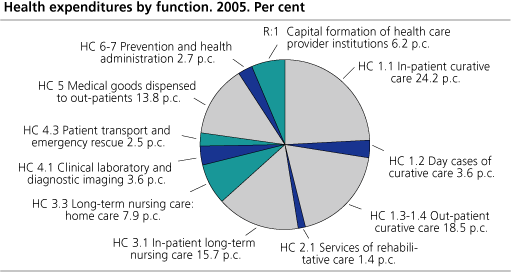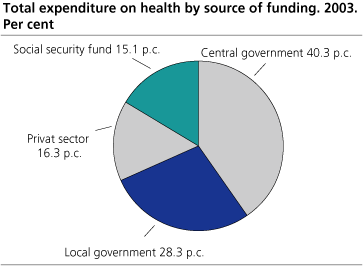Content
Published:
This is an archived release.
NOK 176 billion spent on health in 2005
Total health spending accounted for just above 9 per cent of GDP in Norway in 2005. The share of public spending on health as a share of total public expenditure, has increased from around 16 per cent in 1997 to 19 per cent in 2005.
Total health spending accounted for NOK 176 billion in 2005. In terms of expenditure per capita this corresponds to NOK 38 000, which is almost NOK 17 000 more than in 1997. Measured in constant 2000-prices the annual growth rate was 3.5 per cent per year on average. Expenditures on day care, long term-nursing home care and pharmaceuticals showed the highest growth in real terms.
| Health expenditure, key figures. 1997-2005 |
| 1997 | 1998 | 1999 | 2000 | 2001 | 2002 | 2003 | 2004* | 2005* | |||||||||||||||||||||||||||||||
|---|---|---|---|---|---|---|---|---|---|---|---|---|---|---|---|---|---|---|---|---|---|---|---|---|---|---|---|---|---|---|---|---|---|---|---|---|---|---|---|
| Total expenditure on health. NOK million | 94 008 | 105 500 | 115 711 | 124 728 | 135 266 | 150 029 | 159 572 | 167 259 | 175 579 | ||||||||||||||||||||||||||||||
| HC R.1 Capital formation of health care provider institutions. NOK million | 5 635 | 7 480 | 8 945 | 8 496 | 9 778 | 9 528 | 10 262 | 10 978 | 10 807 | ||||||||||||||||||||||||||||||
| Total current expenditure on health.NOK million | 88 373 | 98 021 | 106 766 | 116 232 | 125 488 | 140 501 | 149 310 | 156 281 | 164 772 | ||||||||||||||||||||||||||||||
| Total expenditure on healt in current prices in per cent of GDP | 8.5 | 9.3 | 9.4 | 8.5 | 8.9 | 9.9 | 10.1 | 9.7 | 9.2 | ||||||||||||||||||||||||||||||
| Total expenditure on health in current prices in per cent of GDP Mainland Norway | 10.4 | 10.8 | 11.2 | 11.3 | 11.6 | 12.4 | 12.7 | 12.6 | 12.4 | ||||||||||||||||||||||||||||||
| Total expenditure on healt in current prices per capita | 21 340 | 23 807 | 25 933 | 27 773 | 29 968 | 33 059 | 34 957 | 36 425 | 37 977 | ||||||||||||||||||||||||||||||
| Total expenditure on health at constant NOK in 2000 per capita | 24 606 | 25 781 | 27 233 | 27 773 | 28 564 | 30 694 | 31 530 | 32 000 | 32 611 | ||||||||||||||||||||||||||||||
Total health spending accounted for about 9 per cent of GDP in 2005. During the years 1997 to 2005 the health expenditure to GDP ratio varied between 8.5 and 10.1 per cent. The relatively large variation over time reflects that the GDP growth rate shows a larger variation than the expenditures on health. This is mainly due to the fluctuations in the prices of oil. Taking this into account and comparing the GDP ratio for mainland Norway, the ratio devoted to health rose from 10.4 in 1997 to 12.4 per cent in 2005. The slight decrease between 2004 and 2005 is caused by a decrease in the grow rate of health expenditure. This is partly due to a more moderate growth in gross capital formation, especially the part financed by the local government, together with a somewhat reduced growth in the current expenditure on health.
Health expenditure by function
In-patient curative care, service of long-term nursing care and pharmaceuticals compose the largest share of health expenditure. The distribution of health expenditure by functions shows minor variations during the period 1997 to 2005
The public sector is the main source of health funding in Norway, composed by general government, the social security fund and the local governments. About 83.6 per cent of health spending was funded by public sources in 2005.The share of public spending in Norway has increased from 81.3 per cent in 1997, and stabilized around 83.5 during the past five years. In contrast the public expenditure on health as a share of total public expenditure has increased from 15.8 i 1997 to 19.1 in 2005. This is caused by a higher public share of funding combined with a rise in health expenditure compared to other public spending.
Health funding
More than 40 per cent of health spending is funded by the central government. In-patient curative and day cases of curative care compose the highest share, accounting for two third of the central government’s expenditures on health. In-patient curative care made up a decreasing share during the period 1997-2005, whereas day cases of curative care increased. During the given period, the expenditures on day cases doubled in real terms. Of the remaining functions clinical laboratory, diagnostic imaging and out-patient curative care are the main expenses of the central government. These services are provided mainly by the hospitals, while the provision by the medical and diagnostic laboratories is increasing.
From January 1 2002 the general government assumed responsibility for the Specialist Health Service from the local government. Since then the main component of the local government health expenditure is related to long term nursing care. These services composed almost two thirds of the local government spending on health. Between 1997 and 2005 the expenses on long term nursing home care increased far above the average, with a real annual growth rate of 8.5 per cent. In contrast the in-patient long-term nursing care increased by 5.2 per cent.
The spending on pharmaceuticals to out-patients has increased above average of the total health spending since 1997. The average annual growth rate reached 7 per cent in real terms. The share of public spending by the social security funds was around 60 per cent in 2005, a bit higher than in 1997.
The private health funding is mainly out of pocket expenditure, on out-patient curative care, especially dental care, pharmaceuticals and long-term nursing care
| Total current expenditure by provider 1997 and 2003. Per cent |
| 1997 | 2003 | ||||||||||||||||||||||||||||||||||||||
|---|---|---|---|---|---|---|---|---|---|---|---|---|---|---|---|---|---|---|---|---|---|---|---|---|---|---|---|---|---|---|---|---|---|---|---|---|---|---|---|
| Total current expenditure on health. NOK million (Sum HP.1-9 and subsidies) | 88 369 | 149 312 | |||||||||||||||||||||||||||||||||||||
| HP.1.1 General hospitals | 30.6 | 28.9 | |||||||||||||||||||||||||||||||||||||
| HP.1.2 Mental health and substance abuse hospitals | 6.9 | 7.7 | |||||||||||||||||||||||||||||||||||||
| HP.1.3 Speciality hospitals | 1.7 | 1.4 | |||||||||||||||||||||||||||||||||||||
| HP.2.1 Nursing care facilities | 16.5 | 17.5 | |||||||||||||||||||||||||||||||||||||
| HP.3.1 Offices of physicians | 8.9 | 8.9 | |||||||||||||||||||||||||||||||||||||
| HP.3.2 Offices of dentists | 6.3 | 5.0 | |||||||||||||||||||||||||||||||||||||
| HP.3.3 Offices of other health practitioners | 1.6 | 1.7 | |||||||||||||||||||||||||||||||||||||
| HP.3.4 Out-patient care centres | 1.0 | 0.9 | |||||||||||||||||||||||||||||||||||||
| HP.3.5 Medical and diagnostic laboratories | 0.5 | 0.6 | |||||||||||||||||||||||||||||||||||||
| HP.3.6 Providers of home health care services | 6.5 | 8.6 | |||||||||||||||||||||||||||||||||||||
| HP.3.9 Other providers of ambulatory health care services | 1.3 | 0.5 | |||||||||||||||||||||||||||||||||||||
| HP.4 Retail sale and other providers of medical goods | 14.4 | 14.4 | |||||||||||||||||||||||||||||||||||||
| HP.5 Provision and administration of public health programmes | 2 | 2 | |||||||||||||||||||||||||||||||||||||
| HP.7.9 All other industries as secondary produsers of health care | 1.7 | 1.7 | |||||||||||||||||||||||||||||||||||||
| HP.9 Rest of the world | 0.1 | 0.3 | |||||||||||||||||||||||||||||||||||||
| Subsidies to health providers | 0.3 | 0.2 | |||||||||||||||||||||||||||||||||||||
Providers of the services
The distribution of health expenditures by providers in 2003 is quite similar to the 1997 distribution. During 1997-2005 almost 30 per cent of the health spending is provided by general hospitals, while around 17 per cent covers nursing care facilities. Offices of dentists compose s lower share in 2005 than in 1997, meaning a growth rate below average.
Mental health and substance abuse hospitals, nursing care facilities and providers of home health care services showed a higher growth rate than the other health care providers.
Norge vs other countries
Total health spending in Norway accounted for 9 per cent of GDP in 2005. This is above the latest available OECD average of health expenditure of 8.6 per cent of GDP in 2002. Norway also ranked above average in terms of total health spending per capita and is, together with other Nordic countries and Japan, one of the countries with the highest share of public funding among the OECD countries.
New updated health figures for 2003 will be released at OECDs website mid june 2006, please see: http://www.oecd.org/home/0,2987,en_2649_201185_1_1_1_1_1,00.html
|
Total expenditure on health measures the final consumption of health care goods and services (i.e. current health expenditures) in addition to capital investment in health care infrastructure. This includes spending by public and private sources (including households) on medical goods and services, public health, preventive health care programmes and administration. The two major components of total current health expenditure are expenditure on personal health care and expenditure on collective services. Personal health care services comprise curative care, rehabilitation, long-term health care, ancillary health care services, and medical goods dispensed to out-patients. Collective services comprise public health tasks such as health promotion and disease prevention services and health administration, which are delivered to society at large. Health expenditure also includes expenditure on health care and social services. According to international guidelines only expenditure for health care and social services that are health related should be included in the health accounts. Long-term nursing care is typically a mix of medical care and social care. Thus only the former is included here. The most important sources for compiling health expenditure are public accounts and statistics from public and private hospitals (specialist nursing homes, convalescence and rehabilitation institutions and hospitals). Health expenditure is defined according to the System of Health Accounts (OECD 2000). |
Tables:
- Table 1 Health expenditure, key figures. 1997-2005
- Table 2 Current expenditure on health, by function of care. 1997-2005. NOK million
- Table 3 Total current expenditure on health by function, distributed by source of funding. 2003. Per cent
- Table 4 Total current expenditure on health by function, distributed by source of funding. 2000. Per cent
- Table 5 Total current expenditure on health by function, distributed by source of funding. 1997. Per cent
- Table 6 Total current expenditure by provider distributed by source of funding. 2003. Per cent
- Table 7 Total current expenditure by provider distributed by source of funding. 1997. Per cent
- Table 8 Total current expenditure by function distributed by provider. 2003. Per cent
Contact
-
Eirik Larsen Lindstrøm
E-mail: eirik.lindstrom@ssb.no
tel.: (+47) 46 78 22 92


